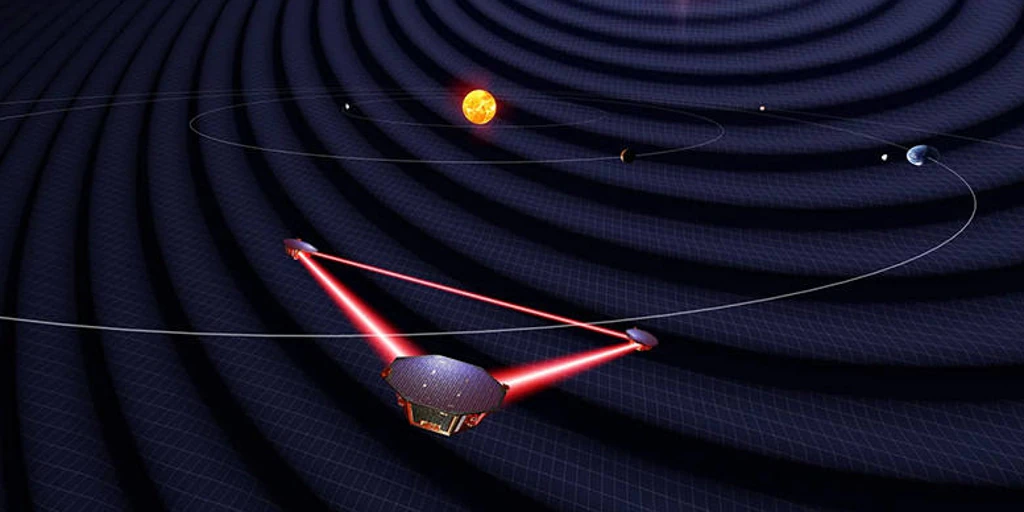The European Space Agency's (ESA) Science Program Committee on Thursday approved Lisa's mission (Space Laser Interferometer Antenna), the first scientific effort to detect and study gravitational waves from space. The mission, which will have a Spanish contribution, will begin construction in 2025 and is likely to be launched ten years later on an Ariane 6 rocket.
LISA is actually a constellation of three spacecraft that will follow the Earth's orbit around the Sun, forming a very precise equilateral triangle in space. Each side of the triangle will be 2.5 million kilometers long (more than six times the distance between Earth and the Moon), and the spacecraft will exchange laser beams across this distance.
The trio will detect gravitational waves throughout the universe, small waves predicted by Einstein just over a century ago, which shake the fabric of space-time and are caused by massive objects accelerating, such as the collision of supermassive black holes at the centers of the universe. Galaxies. This will allow the team to trace the origin of these objects, chart their growth to a mass millions of times greater than that of the Sun, and determine the role they play in the evolution of galaxies.
The first seconds after the big bang
“LISA is an effort that has never been tried before. Using laser beams at distances of up to tens of kilometres, ground-based instruments can detect gravitational waves from events involving star-sized objects, such as supernova explosions or the merger of very dense stars and stellar-mass black holes. “To expand the boundaries of gravity studies, we have to go into space,” explains Nora Lutzgendorf, lead scientist on the LISA project.
The mission is set to capture the gravitational sound of the universe's opening moments, as predicted by current theories, and provide a direct glimpse into the first seconds after the Big Bang. Additionally, because gravitational waves contain information about the distance between the objects they emit, LISA will help the team measure the change in the expansion of the universe at a different standard than techniques used on the Euclid space mission and other studies, validating your information. results.
In our Galaxy, LISA will detect many compact, merging objects, such as white dwarfs or neutron stars, and will give us a unique look at the final stages of the evolution of these systems. By determining their location and distances, they will improve our understanding of the structure of the Milky Way.
To detect gravitational waves, LISA will use solid cubes of gold and platinum, known as test blocks (slightly smaller than Rubik's cubes), which float freely in a special shell at the core of each spacecraft. Gravitational waves will cause small changes in the distances between masses in different spacecraft and the mission will track these differences using laser interferometry.
This technique requires shooting laser beams from one spacecraft to another and then overlaying their signal to determine changes in mass distances down to a few billionths of a millimeter. The spacecraft must be designed so that nothing except the geometry of space-time itself affects the motion of masses in free fall.
The spacecraft follows in the footsteps of its predecessor, LISA Pathfinder, launched in 2015, which demonstrated that it was possible to sustain test masses in free fall with an astonishing level of precision.
Spanish contribution
LISA was made possible thanks to collaboration between ESA, NASA and an international consortium of scientists. The Spanish contribution is led by ICE-CSIC, together with the Institute of Cosmological Sciences of the University of Barcelona (ICCUB) and the Polytechnic University of Catalonia – BarcelonaTech (UPC), through researchers who are all affiliate members of the Institute of Cosmological Sciences. Spatial Studies of Catalonia (IEEC).
The Spanish contribution focuses on the Scientific Diagnostic Subsystem (SDS), one of the three main aeronautical subsystems. Its goal is to measure environmental disturbances on board each of the satellites in the constellation to distinguish them from the effect that gravitational waves might produce. SDS will have temperature, magnetic field and radiation sensors on each satellite.
“To detect gravitational waves, LISA will measure the displacement between masses in free fall in each of the three satellites in space at an unprecedented level down to the picometer level, that is, roughly the size of atoms,” says Miquel Nouvrías, an experimental researcher from ICE. -CSIC and IEC, and a member of the LISA Consortium. In addition, ICE-CSIC will also lead the development of a data distribution center in Spain along with the algorithms needed for its scientific exploitation.





